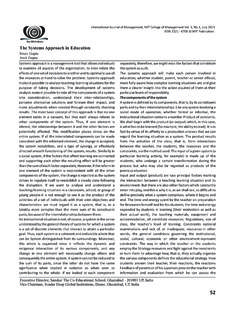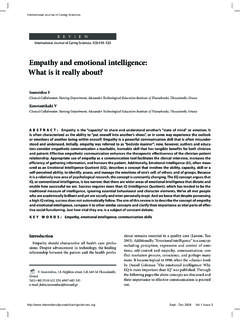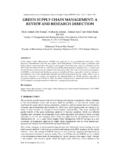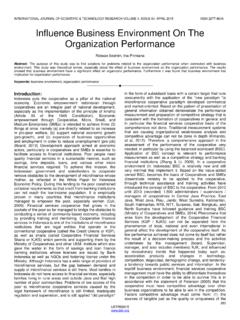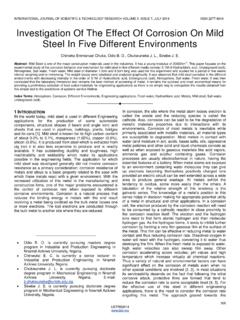Transcription of MIT International Journal of Mechanical …
1 MIT International Journal of Mechanical engineering Vol. 2, No. 2, Aug. 2012, pp. (105-108)ISSN No. 2230-7680 MIT Publications105 Design of Wiped Film Evaporator (WFE) System With Recovery of Working Fluid For Herbal ProductsVijaykumar C. PatelMechanical Department, Research Institute of Technology & ResearchGandhinagar-382015, Indiaemail: Alkesh Mavani Mechanical Institute of Technology & ResearchGandhinagar-382015, Indiaemail: the entire world is taking interest in herbal products. These products are perishable in nature & storage of them required tremendous effect. In cold storage plant, to store such products required lots of power consumption. The electrical energy is costlier & produced using fossile fuel, which is one of the causes for pollution.
2 In case of failure of power supply, the chances of distruction of such commodity is possible therefore this recover of this problem on design of Wiped Film Evaporator with Computer Aided Tools (CAE) for analysis of WFE for OSWAL INDUSTRIES LTD., BILESHWARPURA, DIST. MEHSANAK eywords: Component; Herbal Products, EvaporatorINTRODUCTIONThe process by which any substance is converted from a liquid state into, and carried off in, vapor; as, the evaporation of water, of ether, of camphor. The transformation of a portion of a fluid into vapor, in order to obtain the fixed matter contained in it in a state of greater consistence. That which is evaporated; vapor [1].Equipment used in evaporation, the process of boiling a liquid in order to reduce its volume it is called OF AN EVAPORATORThe main function of an evaporator is to concentrate a solution or to recover a solvent.
3 The evaporator design consists of three principal elements: heat transfer, vapor-liquid separation, and efficient utilization of energy. For evaporators to be efficient, the equipment selected and used must be able to accomplish several things. 1. Transfer large amounts of heat to the solution with a minimum amount of metallic surface area. This requirement, more than all other factors, determines the type, size, and cost of the evaporator system. 2. Achieve the specified separation of liquid and vapor and do it with the simplest devices available. Separation may be important for several reasons: value of the product otherwise lost; pollution; fouling and corrosion of the equipment downstream with which the vapor is contacted.
4 3. Make efficient use of the available energy. This may take several forms. Evaporator performance often is rated on the basis of steam economy, pounds of solvent evaporated per pound of steam used. Heat is required to raise the feed temperature from its initial value to that of the boiling liquid, to provide the energy required to separate liquid solvent from the feed, and to vaporize the solvent. The greatest increase in energy economy is achieved by re-using the vaporized solvent as a heating medium. Energy efficiency may be increased by exchanging heat between the entering feed and the leaving residue or condensate. When this method is used, each evaporator is known as an effect.
5 4. Meet the conditions imposed by the liquid being evaporated or by the solution being concentrated. Factors that must be considered include product quality, salting and scaling, corrosion, foaming, product degradation, holdup, and the need for special types of construction. Between the entering feed and the leaving residue or condensate. When this method is used, each evaporator is known as an effect [4].MIT International Journal of Mechanical engineering Vol. 2, No. 2, Aug. 2012, pp. (105-108)ISSN No. 2230-7680 MIT Publications106 Types of Evaporator [7]Evaporators are broadly classified to four different categories: Evaporators in which heating medium is separated from the evaporating liquid by tubular heating surfaces.
6 Evaporators in which heating medium is confined by coils, jackets, double walls etc. Evaporators in which heating medium is brought into direct contact with the evaporating fluid. Evaporators in which heating is done with solar radiation. The different types of evaporators 1. Horizontal tube evaporators I. Horizontal spray film evaporators 2. Short tube vertical evaporators I. Basket type evaporators II. Inclined tube evaporators 3. Long tube vertical evaporators I. Rising or climbing film evaporators II. Falling film evaporators III. Rising falling film evaporators 4. Forced circulation evaporators 5. Plate evaporators 6. Mechanically aided evaporators I. Agitated vessels II.
7 Scraped surface evaporators III. agitated thin film evaporators (WFE)Wiped Film Evaporator PrincipleThe wiped film evaporator (WFE), also known as an agitated thin-film evaporator (ATFE) is a device often used to purify liquids with viscosities up to 105 poise, to separate temperature-sensitive mixtures, or in general to provide short residence times in heated zones. Unfortunately, the heat and mass transfer mechanisms involved in wiped film evaporators are poorly understood. Users of the technology must rely on equipment vendors and experience for filmed evaporators are designed to spread a thin layer or film of liquid on one side of a metallic wall, with heat supplied to the other side. The unique feature of this equipment is not the thin film itself, but rather the Mechanical wiping device for producing and agitating the film.
8 This Mechanical concept permits the processing of high-viscosity liquids, liquids with suspended solids, or situations requiring liquid rates too small to keep the thermal surface of a falling-film evaporator uniformly WFEs are vertical cylinders (Figure 1) where the feed material is distributed to the inner surface. As the liquid flows downward, axially arranged blades or roller wipers distribute the liquid as a thin film, which is constantly mixed. This type of equipment can operate at very low pressure and provides minimum pressure drop [4].Thin-film evaporation is applied in heat exchangers called thin-film or thin-layer evaporators. Actually thin-layer evaporators may be considered as heat and mass exchangers, since molecules from liquid phase are transferred to gas phase during process of vaporization and the movement of molecules from gas phase to liquid phase is probable during process of condensation.
9 These kinds of devices are commonly applied in chemical, pharmaceutical and food industries since 1950. Vertical thin-layer evaporator, example of which is presented in , is characterized by small pressure drop and short residence time of the phases in the apparatus, which means also that there is short contact time of the liquid with hot surface of the evaporator wall. These features of the evaporator cause that it is applied for the concentration of heat sensitive liquid solutions especially with high viscosity. Because of low value of pressure drop during gas flow inside the evaporator the boiling temperature of liquid, which is evaporated, depends only on its composition and does not depend on liquid position in the evaporator, which is of great importance in case of evaporation at low pressure.
10 There are two main types of the thin-layer evaporator, which will be considered below, namely: static type thin-layer evaporator and mechanically agitated thin-layer evaporator. All types are constituted by vertical cylinder heated from the outside, inside which liquid flows off gravitationally on the heated surface. During that flow vaporization of liquid takes Inlet = kg/hrFeed Inlet Temp. = 30 CB P of Feed Solution = 196 C at ATM. PressureSpecific Heat of feed Solution = kcal/kg C at 32 C kcal/kg C at 196 CLatent Heat of Ethylene Glycol = 204 kcal/kg Q= Fluid Circulation Rate: m=11138kghrDensity of Thermic Fluid is 730 kg/m3 at feed conditions m=15 CONSUMPTIONFeed PumpFeed Rate : kg/hrDensity : 1070 kg/m3 Diff.
